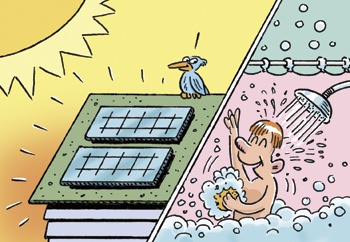If you’re interested in solar energy, you might find that solar water heating is the simplest and most cost-effective way to put this renewable resource to work. New solar industry standards promote quality products and installations, and new federal solar tax credits can take 30 percent off the installed cost of solar water heating for your home or business.
A solar water heater, which harnesses sunlight to produce hot water, features a solar energy collector and a storage tank. It is designed with a dark, heat-absorbing material inside the collector—typically a glazed box or tube. A heat-exchange fluid passes through the collector, gets hot and then runs through a heat exchanger, which transfers the heat to the water in a storage tank.
In the United States, a typical solar water heating system is likely to meet more than half of a household’s water heating needs over the course of a year.
Don’t confuse solar water heating with solar electric systems, also known as high-tech photovoltaics, which use a semiconducting material to convert sunlight into electricity. By comparison, solar water heating is low-tech. It puts the radiant heat energy of the sun directly to work, heating water for household or commercial use.
For best results, solar panels should face south and should be unshaded year-round and for years to come. Some people forget how quickly trees will grow or how long the shadow of an evergreen tree can be.
Which Design Is the Best for You?
Closed-loop antifreeze systems use an antifreeze heat transfer fluid in the collector as freeze protection under harsh winter conditions. A circulating pump, powered by household electricity or by a small photovoltaics panel, moves the fluid through the system. A heat exchanger transfers heat from the fluid to household water. In four-season climates, this is the most popular generic design.
Closed-loop drain-back systems use distilled water with a corrosion inhibitor as the heat transfer fluid that circulates through the collector. Like the antifreeze system, this system also uses a heat exchanger, so the fluid does not mix with household water.
Open-loop direct systems heat and circulate household (potable) water directly through solar energy collectors. One type of open-loop system is a batch heater—simply a tank filled with water and placed on the roof either in a glazed box or attached to a solar collector panel. This type of heater has few parts and is generally reliable. However, it must be protected from freezing or drained for the winter. The design is common for do-it-yourself projects that serve summer homes or workshops.
Shopping Tips
Your electric cooperative is one source of information about qualified solar equipment dealers. Other sources include the Solar Energy Industries Association (www.seia.org), the State Energy Conservation Office (www.seco.cpa.state.tx.us) or the American Solar Energy Society (www.findsolar.com).
Recently, the U.S. Environmental Protection Agency’s Energy Star program (www.energystar.gov) began to label solar water heating equipment and other energy-efficient water heaters.
First Cost, Incentives and Savings
Before incentives, installed costs for a two-panel household solar water heating system typically run between $5,000 and $9,000, depending on the level of freeze protection and other features. Whatever the cost of the installed system, you may be eligible for a 30 percent cost reduction, thanks to the federal tax credit on solar, which now applies to the installed cost (within guidelines) of the system. Check the Database of State Incentives for Renewables and Efficiency (www.dsireusa.org) to see if you qualify.
——————–
Jill K. Cliburn has written several reports for the Cooperative Research Network, a service of the National Rural Electric Cooperative Association.


